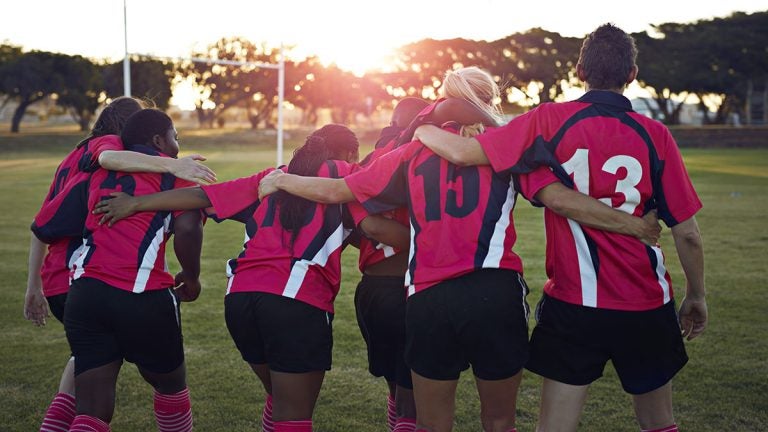Burkini bans prevent Muslim women from health benefits of swimming
Why this matters
Bans and the harassment of burkini-wearing Muslim women keeps them from enjoying beneficial exercise such as swimming.
Traditional Islamic attire requires men to cover from their belly button to their knees and women to cover everything except their hands and faces, typically donning a hijab.
Because these attire guidelines include swimwear, Muslim women don burkinis. A burkini covers a woman’s body, exposing the face, hands and feet, while being made of a light material that is suitable for swimming.
However, Muslim women who wear the burkini have been harassed and kicked off beaches in Europe and the United States.
The harassment, or the fear of it, keeps many Muslim women away from public pools and beaches and denies them the benefits of swimming.
“Your identity is so bound up in what you do, and if you are no longer doing that you have serious issues with loss of identity, loss of purpose, depression, anxiety, a confrontation of those big life questions,” ASU clinical assistant professor of history Victoria Jackson said. “Depending on the circumstances and situation of the individual, it can become quite overwhelming.”
Swimming is a great exercise. It works all of a person’s muscles without stressing joints or other body parts as running would. Swimming strengthens the heart and lungs while reducing the risk of death. According to the U.S. National Library of Medicine, swimming has been shown to lower blood pressure and control blood sugar.
The harassment and fear is not limited to Muslim women in any one country. Several places have banned the burkini at public swimming areas. A few years ago, numerous French towns banned the swimwear in light of ISIS terror attacks in France from 2015-2018.
The first town to issue this type of ban was Cannes, France, a town of 75,000 on the nation’s southeast coast. The town’s mayor, David Lisnard, stated he wanted to ban beachwear that was “ostentatiously showing a religious affiliation while France and places of religious significance are the target of terror attacks.”
Other towns in France, such as Villeneuve-Loubet, declared the only clothing allowed was “(clothing that is) respectful to morality and secular principles, and in compliance with hygiene and safety rules.”
A tribunal upheld the ban, ruling it was “necessary, appropriate and proportionate to prevent public disorder.”
Similar issues have arisen in the United States, ranging from controversy over concerns pool sanitation by lifeguards and other poolgoers to straight-up harassment.
The Huffington Post spoke to numerous Muslim women across the United States who described incidents of harassment, including one where a burkini-wearing Muslim mother was approached by staff members at a waterpark in Toledo, Ohio, who questioned her outfit.
Before Manar Hussein, a 27-year-old Muslim woman living in New Jersey, began wearing a hijab as a teenager, she spent hours on end at a local pool. One day she witnessed a burkini-wearing Muslim woman being harassed at the pool; people demanded she get kicked out because her clothing was unsanitary.
This was one of the reasons that caused Hussein to avoid the pool for many years, scared by the fear that she could be the victim of this public humiliation.
According to the Lifesaving Society, an organization whose mission is to promote safe interactions with water to prevent drowning and other injuries, a burkini is an acceptable and hygenic article of swimwear.
“Burkinis and rash guards are examples of acceptable alternative swimwear as face and neck are uncovered and fabric is tight-fitting enough to do not interfere with swimming skills. Hands and feet can move freely and there is an additional element of hygiene if hair is covered,” the site states.
Muslims are not the only religious group whose beliefs impose restrictions on their swimwear. Both Orthodox Jews and Mormons wear swimwear that covers much of their bodies, similar to the burkini. However, only the burkini ignites a significant and widespread backlash.
“A woman playing a sport and using her body for her own pleasure and power is transgressive,” Jackson said. “Historically, a woman doing this, especially if it falls into public space, has been met with resistance. Violent, verbal, all forms of resistance.”
Jackson draws the parallel to when women first started playing sports in the 19th century.
“There was a basketball craze, women were playing basketball in high numbers, and the greater public didn’t know what to do with it,” she said.
Jackson described how women’s dress in the 19th century bears similarities to what Muslim women wear now. It was marked by long dresses, sleeves and corsets. Much like the burkini today, the general public(in this case men) didn’t know how to react to the situation.
“Oftentimes, they play in closed-off areas where men couldn’t watch because of the fear of what men would do when they saw an exposed ankle,” Jackson said.
It took the public a while to embrace the image of women playing basketball in the early 20th century, and some places have taken steps to familiarize the public with the image of a burkini.
Sports Illustrated featured its first burkini-wearing model in the magazine’s most recent swimsuit edition, Halima Aden, a 21-year-old Somali-American model originally from Kenya.
“Embracing all cultures, and those cultures finding ways to promote and support women in sport is awesome, and especially in the U.S. or in other countries where that might be seen as something that is not as typical or something that you would see regularly if you were to go to the beach,” Jackson said.
“To put it in such a mainstream national publication like that means Sports Illustrated is thinking about its place in the world and promoting and advocating for more women and girls to play.”
There are places that try to give opportunities for Muslim women to get in the pool. Zahara Hassan of the Minneapolis non-profit Fairview Health Services works to make opportunities available to Muslim woman and girls, according to MPR News. The organization offers free swimming lessons to them once a week, with no men allowed.
“It makes it easier for the community to learn when they know that they can be in a pool where they don't have to worry about wearing a scarf,” she said. “They can wear whatever they want in the pool, as long as the windows are covered. We have a female instructor, a female lifeguard. It's great.”
TJ Mathewson is a senior journalism student at Arizona State University






